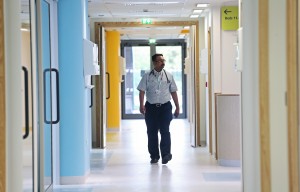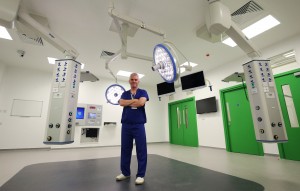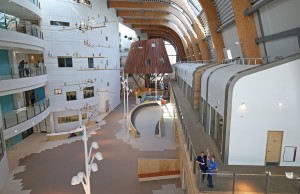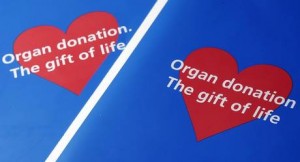Long QT syndrome causes problems with the electrical activity of the heart. It’s uncommon, occurring in around 1 in every 2,000 people.
Long QT syndrome is often the result of a faulty gene that’s inherited from one of your parents. The abnormal gene causes an imbalance in the chemicals that create the electric impulses in your heart.
The syndrome can also be caused by medicines for other conditions.
Symptoms of long QT syndrome
There are usually no physical signs of long QT syndrome, and some people don’t experience any symptoms.
The most common symptoms are blackouts or seizures caused by the interruptions to the heart’s rhythm.
Some people with long QT syndrome find that their heart sometimes suddenly beats in an abnormally fast, uncontrollable way. This type of arrhythmia is called “torsade de pointes”.
When this happens, the heart can’t pump blood properly and the brain is temporarily starved of oxygen, causing the person to temporarily pass out. The heart’s rhythm usually returns to normal within a minute or so and the person regains consciousness.
These episodes can start at any age and may be triggered by:
stress
a sudden noise – such as an alarm bell
strenuous exercise – particularly swimming
a slow heart rate during sleep
However, there isn’t always a trigger.
Sometimes, the abnormal heart rhythm persists, leading to ventricular fibrillation (a rapid, uncoordinated series of contractions). This rarely reverts to normal without medication and, if it isn’t electrically corrected, usually causes the heart to stop pumping (cardiac arrest) and death.
Dial 999 to request an ambulance if someone with long QT syndrome suddenly collapses. Perform cardiopulmonary resuscitation (CPR) until medical help arrives.
Long QT syndrome is a leading cause of sudden cardiac death in young, otherwise healthy people, and is often thought to be an underlying cause of sudden infant death syndrome (SIDS).
What causes long QT syndrome?
To understand the underlying cause of long QT syndrome, it’s important to know how the heart cells work.
On the surface of each heart muscle cell are tiny pores, or ion channels. These open and close to let electrically charged sodium, calcium and potassium atoms (ions) flow into and out of the cells.
This passage of ions generates the heart’s electrical activity. The electrical signal spreads from the top of the heart to the bottom, causing the heart to contract and pump blood.
In most cases of long QT syndrome, the flow of potassium ions out of the heart muscle’s cells is delayed. This means that after each heartbeat, your heart can take longer to reset itself.
Inherited long QT syndrome
Long QT syndrome is often inherited from a parent as a faulty gene. The abnormal gene affects the proteins that make up the ion channels in the heart cells. The ion channels may not work well, or there may not be enough of them, which disrupts the heart’s electrical activity.
Cardiac Risk in the Young has published a list of medications that people with long QT syndrome should avoid.
Drug-induced long QT syndrome usually happens in people with an inherited higher risk of developing it, such as those with slight genetic heart defects.
For more information, you can read the Sudden Arrhythmic Death Sydrome’s (SADS UK) guide about acquired, drug-induced long QT syndrome (PDF, 158kb).
What does ‘long QT’ mean?
Every time your heart beats, it produces tiny electrical signals. An electrocardiogram (ECG) machine traces these signals on paper – a typical pattern is shown below.
As the graph shows, each heartbeat is mapped as five distinct electrical waves – P, Q, R, S and T. The part of the pattern from Q to T represents the electrical activity of the heart’s lower chambers, or ventricles.
In people with long QT syndrome, this QT interval lasts abnormally long. In other words, it takes longer for the heart cells in the ventricles to recharge after each heartbeat. This can upset the timing of the heartbeat and may trigger an abnormally fast heart rhythm.
Diagnosing long QT syndrome
If your GP thinks you have long QT syndrome after assessing your symptoms, they may recommend that you have an ECG and refer you to a heart specialist (cardiologist).
In particular, if blackouts have occurred during exercise, or if there’s a family history of sudden cardiac death below the age of 40, specialist assessment is needed.
An ECG is a test that records your heart’s rhythm and electrical activity. If you have long QT syndrome, the trace of the QT section will be longer than normal.
During an ECG, sticky pads called electrodes are stuck on your arms, legs and chest, and connected by wires to an ECG machine. The test may need to be carried out while you exercise on a treadmill, as well as during rest.
Genetic testing may be needed to identify the defective gene that may be causing long QT syndrome. It can also help to determine which family members may have inherited the defective gene and need clinical assessment.
Treating long QT syndrome
Most people with inherited long QT syndrome will need treatment with medicines. Beta-blockers, such as propranolol or nadolol, may be prescribed to help control irregular heartbeats and slow down your heart rate.
If your symptoms are frequent or severe, and you have a high risk of having a life-threatening arrhythmia, you may need to have a pacemaker or implantable cardioverter defibrillator (ICD) fitted.
Like pacemakers, ICDs are small battery-powered devices. If the ICD senses that the heart is beating at a potentially dangerous abnormal rate, it will deliver an electric shock that returns the heart rhythm to normal.
In some cases of long QT syndrome, surgery may be needed to control the flow of chemicals into the heart.
If you have long QT syndrome caused by taking medication, your medication will be reviewed. It may be possible to prescribe alternative medication that doesn’t adversely affect your QT interval.
Living with long QT syndrome
With appropriate treatment, such as medication or surgery, it should be possible to lead a relatively normal lifestyle. However, you may need to make some lifestyle adjustments to reduce your risk of having blackouts.
For example, your doctor may advise you not to exercise strenuously or play contact sports, and to try to avoid startling noises, such as alarm clocks or telephones with loud ringtones. Avoiding stressful situations may also be recommended.
Your doctor may prescribe potassium supplements or suggest that you increase the amount of potassium-rich foods in your diet. Good sources of potassium include:
fruit – such as bananas
vegetables
pulses
nuts and seeds
milk
fish
shellfish
beef
chicken
turkey
bread
Always tell medical staff that you have long QT syndrome. Any new medication, both prescription or over-the-counter, will need to be carefully checked to see if it’s suitable for you.






